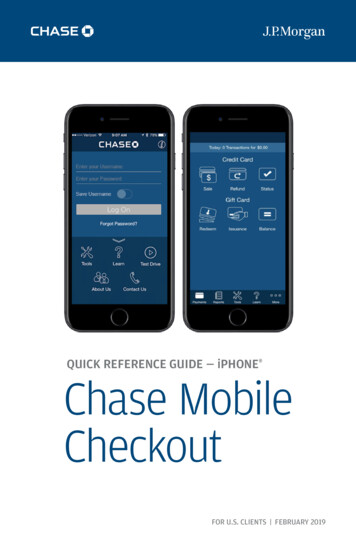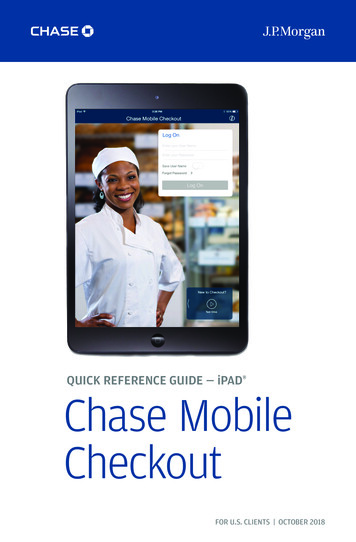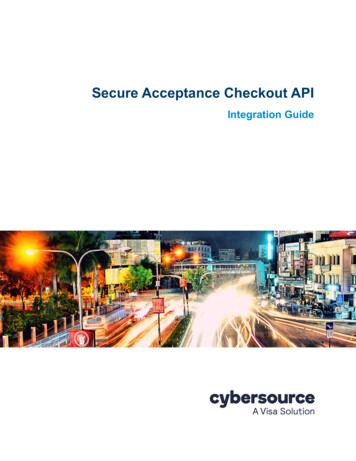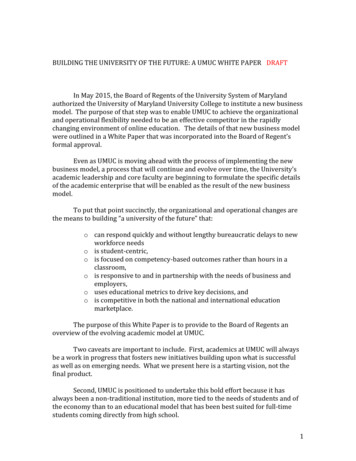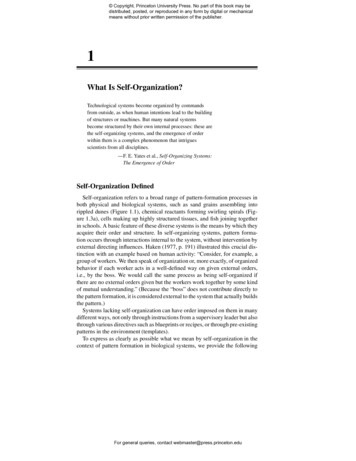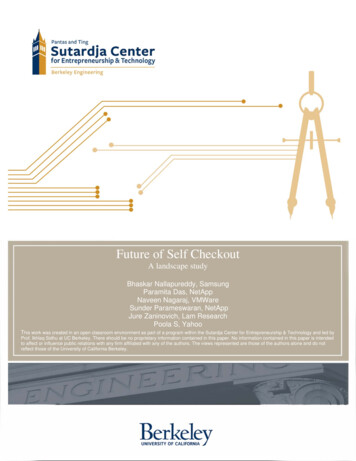
Transcription
Future of Self CheckoutA landscape studyBhaskar Nallapureddy, SamsungParamita Das, NetAppNaveen Nagaraj, VMWareSunder Parameswaran, NetAppJure Zaninovich, Lam ResearchPoola S, YahooThis work was created in an open classroom environment as part of a program within the Sutardja Center for Entrepreneurship & Technology and led byProf. Ikhlaq Sidhu at UC Berkeley. There should be no proprietary information contained in this paper. No information contained in this paper is intendedto affect or influence public relations with any firm affiliated with any of the authors. The views represented are those of the authors alone and do notreflect those of the University of California Berkeley.
Abstract“People have said when checkout is working really well, it will feel like stealing. Yougrab a pair of shoes and you just walk out.”‐ Michael Chui, Partner, McKinsey Global InstituteWho would not like an ideal shopping experience – imagine that you walk into astore, browse products, compare pricing, read reviews, drop the products in yourcart and walk out. This is not inconceivable in the not‐too‐distant future.This report covers the current state and the future of retail checkout, which is at aninflection point and is ripe for a disruptive change in the near to mid term horizon. Itoutlines the pain points for the consumer and the retailer, and identifies an existingbusiness opportunity as recognized by industry players. It covers the technologiesin action, their potential for disruption, industry players in the game, challenges toovercome, and the authors’ opinion on the winners and losers in the retail selfcheckout industry. Besides, it also covers a handful of case studies of industryplayers, both incumbents and disruptors that sheds some light on the players whoare positioned to capitalize on the huge opportunity.KeywordsRetail, Self‐checkout, RFID, barcode, Digimarc, Scandit, NCR, SkipAbbreviationsPOSNRFAIDCCPGSNRGTINPoint Of SaleNational Retail FederationAutomatic Identification and Data CaptureConsumer Packaged GoodsSignal to Noise RatioRBRGlobal Trade Item Number (Managed by GS1 standards)Retail Banking ResearchGS1ROIGlobal Standards One (an organization that manages standards)Return On Investment1
TABLE OF CONTENTSABSTRACT . 1KEYWORDS . 1ABBREVIATIONS . 11.INTRODUCTION . 42.RETAIL CHECKOUT . 4I.II.A BIT OF HISTORY . 5INDUSTRY TODAY AND KEY PLAYERS . 63.PAINPOINTS AND OPPORTUNITY . 84.TECHNOLOGIES . 10I.BARCODE . 10TECHNOLOGY . 10KEY BENEFITS . 11II. DIGIMARC BARCODE . 11TECHNOLOGY . 12KEY BENEFITS . 14III. RFID . 14TECHNOLOGY . 14KEY BENEFITS . 165.CASE STUDIES . 16I.NCR: THE MARKET LEADER. 16OVERVIEW . 16CUSTOMERS . 17VALUE PROPOSITION . 17II. SCANDIT: LEVERAGING THE SMARTPHONE BOOM . 18OVERVIEW . 18CUSTOMERS .1918VALUE PROPOSITION . 19III. DIGIMARC: RADICAL IDENTIFICATION AND CAPTURE . 19OVERVIEW . 19CUSTOMERS AND PARTNERS . 20VALUE PROPOSITION . 21IV. SKIP: RFID, THE FINAL DESTINATION? . 22OVERVIEW . 22CUSTOMERS . 23VALUE PROPOSITION . 236.KEY HURDLES FOR ADOPTION . 242
I.II.III.TECHNOLOGY . 24REGULATORY . 24SOCIETAL. 247.CONCLUSIONS . 25REFERENCES . 27TABLE OF FIGURESFigure 1: Benefits of barcode [7] . 5Figure 2: Evolution of checkout . 6Figure 3: Industry players in self checkout. 7Figure 4: Self checkout terminal shipments worldwide (210,000), 2014 . 8Figure 5: Customer pain points and impact to business . 9Figure 6: Retailers response to checkout pain point . 9Figure 7: Sample types of barcodes . 11Figure 8: Code Embedder . 13Figure 9: Code Detector . 13Figure 10: RFID factory selling price trend . 15Figure 11: NCR self checkout platform . 17Figure 13: Digimarc watermark encoding . 20Figure 14: Datalogic devices with integrated Digimarc barcodes . 21Figure 15: Skip operation . 23TABLE OF TABLESTable 1: ROI of the hypothetical retailer. 21Table 2: Labor cost savings expected in the 3 trillion business (top 120supermarket like retail segments). 22Table 3: Expected outcomes . 253
1. INTRODUCTION“People have said when checkout is working really well, it will feel like stealing. Yougrab a pair of shoes and you just walk out.” That’s how Michael Chui, a partner at theMcKinsey Global Institute, describes the retail‐checkout experience in your not‐too‐distant future [1].The way we pay for goods and services at stores and restaurants is changing as thetraditional POS (Point Of Sale) counters gets replaced by new technologies. Manystores and small businesses are already using tablets or mobile phones that swipedebit or credit cards. Purchases can now take place anywhere in the store thanks tomobile payment technologies such as Apple Pay, Samsung Pay. While this is the tipof an iceberg ‐ a much bigger change in the overall checkout experience is coming ‐it illustrates the industry’s recognition of an existing opportunity, and that bigplayers are responding with a variety of solutions to radically change the consumerexperience of retail checkout.An ambitious concept, Touchless commerce [2], showcased by Toshiba in NRF(National Retail Federation)’s Big Show in New York City in early 2015 combines 3Dand facial recognition to quickly scan consumers face and the content of the basketand immediately charges the consumer. As presented in the show, the scanningwould be limited to 8‐10 items in a supermarket basket and is far from achievingthe required identification targets to make the technology realizable. Sometime inthe future, as such technologies cross the barriers of adoption, we will essentiallysee an end to the concept of checkout.We would like to imagine a future where in we could walk into a store, shop, andjust walk out of the store with a filled cart fully paid for. While this requiresdisruptive innovations in POS solutions, mainly from scanning and paymentsystems, the latter has seen significant improvements and the former remains thekey bottleneck in eliminating long lines at checkout.In this report, we will share our findings from our study and analysis of the retailself‐checkout landscape.2. RETAIL CHECKOUTKey bottleneck in the checkout experience is in data capture (scanning) andidentification, often referred to in the industry as Automatic Identification and DataCapture (AIDC). Barcodes are the classic example of AIDC technology that has beensuccessfully adopted in retail.4
In this section, we will briefly cover the evolution of check out experience in the lasthalf a century following which we will share the current state of the industry.i.A BIT OF HISTORYRetail checkout without barcode is almost unimaginable today. First use of barcodecommercially dates back to 1974 in a store in Ohio [7]. Small businesses beforebarcodes spent an enormous time with inventory maintenance, as summed up inFigure 1: Benefits of barcode.Figure 1: Benefits of barcode [7]5
Over time, barcodes got adopted from inventory management into the front of theline retail POS thereby enhancing the checkout experience for the customers, andenabling the scalability of retail stores to support a large number of transactions.Figure 2: Evolution of checkout shows the technologies used historically atcheckout. As we can see, the biggest disruptor so far, was the bar code and wasinvented about 40years ago. The figure shows that the recent evolutions have allbeen incremental in their value proposition, and we can say that the next big thingafter barcodes was the self‐checkout counter. The checkout industry is ripe for adisruption. Some of the key players in this game are mentioned in the nextsubsection including the technologies that they are evaluating for the nextgeneration products.2015 – 2025RFID scanners2000 ‐ 20151980 ‐ 2000Bar code scanners atthe cash countersSelf‐checkout kiosksand Smartphonebarcode readers1970Numerical codeswere Keyed at theregister1960Manual entryof items andpricesFigure 2: Evolution of checkoutii.INDUSTRY TODAY AND KEY PLAYERSIn this report, we focus more on the retail self‐checkout landscape rather than retailcheckout as a whole. Thus, we identified the players in the self‐checkout business. InFigure 3: Industry players in , we show the key players that include incumbents aswell as disruptors. In specific, Horizon 1 companies (firms with stable products andsteady market share with little growth) constitute the incumbents with NCR beingthe market leader. IBM was also a key player in retail self‐checkout business andappears here as Toshiba after the sale of the retail business division to Toshiba.6
As seen in Figure 3: Industry players in , there are a bunch of disruptors withdifferent approaches to solve the long check out line problem. Scandit follows thenatural evolution, an obvious next step, with the advent and widespread adoption ofsmartphones. It is essentially a smart phone based bar code scanning andintegration into the retail checkout system.Digimarc on the other hand, developed a radically new barcode technology based onimage watermarking and is showing good promise of a large‐scale adoption. Also,there are other small players such as shelfX that take us a step towards unmannedPOS at the shelf level. Skip, is betting on the next big radically disruptive RFIDtechnology. Apart from there, there are moonshots such as Toshiba’s idea ofbasket/cart level image recognition based checkout and facial recognition basedpayment that will essentially completely remove the concept of checkout from thestores. We do not cover Toshiba’s idea in this report since we believe that it is wayfar in terms of technical feasibility.Figure 3: Industry players in self‐checkoutSkip, Scandit, shelfX and Digimarc are relatively smaller companies in the self‐checkout business. The dominant players in the self‐checkout terminal business areshown in Figure 4: Self checkout terminal shipments worldwide (210,000), 2014,which obtained from a recent market share data by Retail Banking Research (RBR).7
Figure 4: Self checkout terminal shipments worldwide (210,000), 20143. PAINPOINTS AND OPPORTUNITYCheckout is the last opportunity for the retailer to make an impression on theconsumer. Long lines at checkout could ruin the entire experience even though theconsumer had the best possible shopping experience until then. The problem of longlines and the resulting frustration of the consumer needs no significant data forjustification since most of us have the first hand experience.The key pain point is the impact to the retail business. As shown by theretailcustomerexperience.com stats in Figure 5: Customer pain points and impact tobusiness, brick‐and‐mortar stores are losing customers/business due to longcheckout lines. A survey of US internet users by eMarketer shows at least about 30%of the participants indicate that they would go back to brick‐and‐mortar stores ifsmooth and quick self‐checkout options existed. Also, a Harris poll data from 2013showed that a staggering 88% of US adults want their retail checkout experience tobe faster.All the noted survey results indicate a clear hole or an opportunity to improve theexperience. A different VDC survey of the retail organizations, shown in Figure 6:Retailers response to checkout clearly indicates that organizations are respondingto this pressing need. 85% of surveyed businesses are considering upgrading theirPOS scanning systems.8
Figure 5: Customer pain points and impact to businessFigure 6: Retailers response to checkout pain pointSince, brick‐and‐mortar retail is about a 22 trillion business globally and thescanning portion of checkout costs about 0.4% of sales (based on data used byDigimarc covering top 120 supermarket/hypermarket chains globally), the businessopportunity is 88 billion for completely eliminating scanning from the checkoutflow. This presents an attractive opportunity for businesses to improve efficiencies.9
In the next section, we will discuss the key technologies that are being explored totap this large opportunity.4. TECHNOLOGIESi.BarcodeBarcodes are considered as one of the greatest inventions of the 20th century. One ofthe original forms of the bar code, when it was invented back in 1948 by NormanWoodland, was inspired by Morse code, essentially a vertical extension of the dotsand lines in Morse code. Later on it took the form of circular bulls eye shapedpattern in order to make it robust against orientation. Eventually, when it wascommercially implemented in 1974, it had taken the form that we see today. Thereare many different kinds of barcodes such as the retail Universal Product Code(UPC), the postal code and many more as shown in [10].TechnologyBarcode technology works of off a principle called Symbology carrying encodeddata. This encoding allows the scanning device to know when a digit or characterstarts and when it stops, similar to a binary representation. We recognize barcodesas an array of parallel lines alternating between white and black lines. Barcodetechnology provides a simple and inexpensive method of recording data orinformation in a number of applications.The line or linear barcode technology is sometimes r
distant future [1]. The way we pay for goods and services at stores and restaurants is changing as the traditional POS (Point Of Sale) counters gets replaced by new technologies. Many stores and small businesses are already using tablets or mobile phones that swipe debit or credit cards. Purchases can now take place anywhere in the store thanks toFile Size: 1MB
